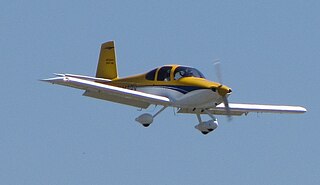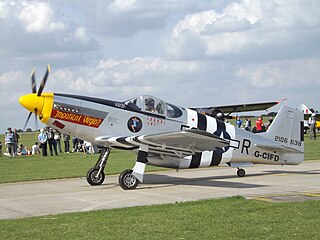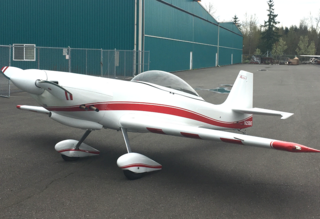
The Pitts Special is a series of light aerobatic biplanes designed by Curtis Pitts. It has accumulated many competition wins since its first flight in 1944. The Pitts biplanes dominated world aerobatic competition in the 1960s and 1970s and, even today, remain potent competition aircraft in the lower categories.

The Van's Aircraft RV-10 is a four-seat, single-engine, low-wing homebuilt airplane sold in kit form by Van's Aircraft. It is the first four-seat airplane in the popular RV series. The RV-10 first flew on 29 May 2003, and the first kit parts were delivered to a customer in September 2003.

The Titan T-51 Mustang is a three-quarter scale replica of the P-51 Mustang that was designed by Titan Aircraft owner John Williams. It is a two-seat homebuilt aircraft with dual controls and tandem seats, and has remarkable performance given the small size of the engine.

The Bradley BA 100 Aerobat is an American aerobatic homebuilt aircraft that was designed and produced by Bradley Aerospace of Chico, California. When it was available the aircraft was supplied as a kit for amateur construction.

The Jurca Gnatsum is a French homebuilt near scale replica aircraft based on the North American P-51 Mustang.
The Mini Mustang was a scale replica of the P-51 Mustang. It featured aluminium construction and manual retractable landing gear.

The Loehle 5151 Mustang is a 3/4 scale replica of the P-51 Mustang, designed by American designer Carl Loehle. Its plans are provided for amateur builders. The aircraft has a wooden fuselage with fabric covering.
The Cameron P-51G is an American two-seat turboprop representation of the 1940s North American P-51 Mustang, designed and built by Cameron & Sons Aircraft of Coeur d'Alene, Idaho for sale as completed aircraft or kits for amateur construction.
The Falconar SAL Mustang, also called the 2/3 Mustang and the SAL P-51D Mustang is a Canadian amateur-built aircraft, originally produced by Falconar Avia and introduced in 1969. The aircraft is a 2⁄3 scale replica of the North American P-51 Mustang and is supplied as a kit or as plans for amateur construction.

The Rihn DR-107 One Design is an American aerobatic homebuilt aircraft that was designed by Dan Rihn and first flown in 1993. The aircraft is supplied by Aircraft Spruce & Specialty of Corona, California in the form of plans and a materials kit for amateur construction.
The Rihn DR-109 is an American aerobatic homebuilt aircraft that was designed by Dan Rihn. The aircraft was supplied by Jim Kimball Enterprises of Zellwood, Florida and more recently by Ashcraft Aero Works of Aurora, Illinois in the form of plans. It was designed for competition aerobatics as well as a trainer for the Rihn DR-107 One Design.

The Aircraft Technologies Acro 1 is an American aerobatic homebuilt aircraft that was designed by Fred Meyer and produced by Aircraft Technologies of Lilburn, Georgia. When it was available the aircraft was supplied as a kit or in the form of plans for amateur construction. Neither plans nor kits are available anymore and the aircraft is out of production.
The Giles G-200 is an American aerobatic homebuilt aircraft that was produced by AkroTech Aviation of Scappoose, Oregon. When it was available the aircraft was supplied as a complete ready-to-fly-aircraft or a kit for amateur construction. The first customer-built aircraft made its first flight on May 26, 1996. AkroTech Aviation went out of business and the design is no longer in production.

The Culp Special is an American aerobatic homebuilt aircraft designed and produced by Culp's Specialties of Shreveport, Louisiana. The aircraft is supplied as a kit or in the form of plans for amateur construction.
The Historical P-51 Mustang is an American homebuilt aircraft that was designed and produced by the Historical Aircraft Corporation of Nucla, Colorado. The aircraft is a 62.5% scale replica of the original North American P-51 Mustang and when it was available was supplied as a kit for amateur construction.
The Junkers Profly Ultima is a German aerobatic homebuilt aircraft that was designed by Andre Konig and produced by Junkers Profly of Kodnitz, introduced in 1993. When it was available the aircraft was supplied as a kit for amateur construction.

The Reflex Lightning Bug, also called the Jones Lightning Bug, is an American homebuilt aircraft that was designed by Nick Jones and produced by Reflex Fiberglass Works of Walterboro, South Carolina, introduced in the mid-1990s. When it was available the aircraft was supplied as a kit for amateur construction.

The SkyDancer SD-260 was an American aerobatic homebuilt biplane that was designed and produced by SkyDancer Aviation of Louisville, Kentucky, introduced in the mid-1990s. When it was available the aircraft was supplied as a kit.
The Tech Aero TR 200 is a French homebuilt aerobatic aircraft that was designed and produced by Tech Aero of Glisolles, first flown in August 1988. When it was available the aircraft was supplied as a kit for amateur construction.
The Viper Aircraft Viperfan was an American homebuilt aircraft that was designed and produced by Viper Aircraft of Kennewick, Washington, introduced in the late 1990s. It was intended to be supplied as a kit for amateur construction, but only one was ever built.











